
Thelypteridaceae is a family of about 900 species of ferns in the order Polypodiales. In the Pteridophyte Phylogeny Group classification of 2016, it is placed in the suborder Aspleniineae. Alternatively, the family may be submerged in a very broadly defined family Aspleniaceae as the subfamily Thelypteridoideae.

The Dryopteridaceae are a family of leptosporangiate ferns in the order Polypodiales. They are known colloquially as the wood ferns. In the Pteridophyte Phylogeny Group classification of 2016 (PPG I), the family is placed in the suborder Polypodiineae. Alternatively, it may be treated as the subfamily Dryopteridoideae of a very broadly defined family Polypodiaceae sensu lato.

Woodwardia is a genus of ferns in the family Blechnaceae, in the suborder Aspleniineae of the order Polypodiales. Species are known as netted-chain ferns. The genus is native to warm temperate and subtropical regions of the Northern Hemisphere. They are large ferns, with fronds growing to 50–300 cm long depending on the species. The fossil record of the genus extends to the Paleocene.
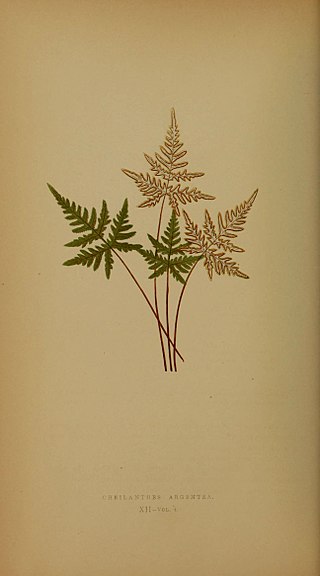
Aleuritopteris is a genus of ferns in the Cheilanthoideae subfamily of the Pteridaceae. As with some other genera of the Cheilanthoideae, molecular phylogenetic studies have suggested that it is not monophyletic, and so may need to be circumscribed differently in future.

Diplazium is a genus of ferns that specifically includes the approximately 400 known species of twinsorus ferns. The Greek root is diplazein meaning double: the indusia in this genus lie on both sides of the vein. These ferns were earlier considered part of either the Athyriaceae, Dryopteridaceae, Aspleniaceae, or Polypodiaceae families or recognized as belonging to their own taxonomic family. The Pteridophyte Phylogeny Group classification of 2016 places the genus in the Athyriaceae. The taxonomy of the genus is difficult and poorly known, and by 2009 has never been the subject of a complete monographic study. Their distribution is pantropical, with a few species extending into temperate areas.
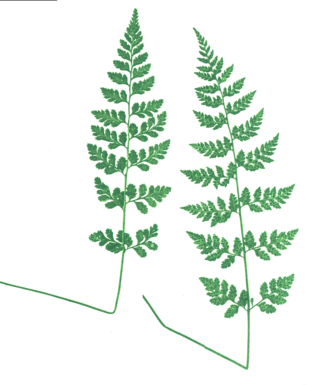
Cystopteris protrusa is a common fern of North America, commonly known as the lowland bladderfern, lowland brittle fern or lowland fragile fern.

Hybridization and polyploidy are common phenomena in ferns, and the genus Dryopteris is known to be one of the most freely-hybridizing fern genera. North American botanists recognized early that there were close relationships between many of the species of Dryopteris on the continent, and that these relationships reflected hybrid ancestry. The complex includes six sexual diploid parents, six sexual allopolyploids, and numerous sterile hybrids at various ploidal levels.
The fern genus Asplenium is well known for its hybridization capacity, especially in temperate zones.

Cystopteris bulbifera, with the common name bulblet fern, bulblet bladderfern, or bulblet fragile fern is a fern in the family Cystopteridaceae.
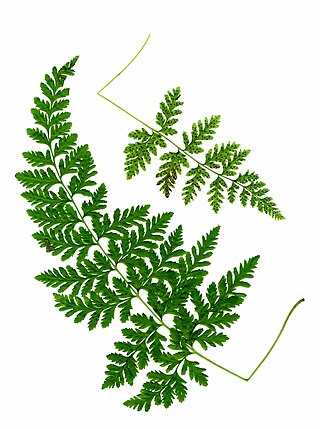
Cystopteris tenuis is sometimes known as Mackay's bladder fern or Mackay's fragile fern. It was long considered to be a part of the superspecies for fragile ferns, as Cystopteris fragilis(L.) Bernh. var. mackayiLawson.

Cystopteridaceae is a family of ferns in the order Polypodiales. In the Pteridophyte Phylogeny Group classification of 2016 (PPG I), the family is placed in the suborder Aspleniineae of the order Polypodiales, and includes three genera. Alternatively, it may be treated as the subfamily Cystopteridoideae of a very broadly defined family Aspleniaceae.
C. fragilis may refer to:
Rhachidosorus is a genus of ferns in the order Polypodiales. It is the only genus in the family Rhachidosoraceae in the Pteridophyte Phylogeny Group classification of 2016. Alternatively, the genus may be placed in the subfamily Rhachidosoroideae of a more broadly defined family Aspleniaceae, the family placement used in Plants of the World Online as of November 2019.
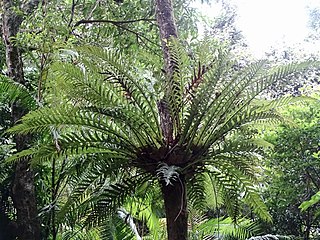
Drynarioideae is a subfamily of the fern family Polypodiaceae in the Pteridophyte Phylogeny Group classification of 2016 (PPG I). The subfamily is also treated as the tribe Drynarieae within a very broadly defined family Polypodiaceae sensu lato. In either case, it includes the previously separated tribe Selligueeae.

Vittarioideae is a subfamily of the fern family Pteridaceae, in the order Polypodiales. The subfamily includes the previous families Adiantaceae and Vittariaceae.

Hemionitis is a genus of ferns in the subfamily Cheilanthoideae of the family Pteridaceae. Its circumscription varies greatly in different systems of fern classification. In the Pteridophyte Phylogeny Group classification of 2016, it was one of more than 20 genera in the subfamily Cheilanthoideae, and was said to have five species. Other sources treat it as the only genus in the subfamily, and so accept about 450 species. With the restricted circumscription, species are native to tropical America.

Cystopteris laurentiana, commonly called Laurentian bladderfern or St. Lawrence bladderfern, is a species of fern in the family Cystopteridaceae. It is native to eastern North America, primarily in the Great Lakes-St. Lawrence lowlands, but there are also scattered occurrences in New England and Atlantic Canada. It grows on cliffs composed of calcareous rocks, such as limestone, dolostone and diabase.
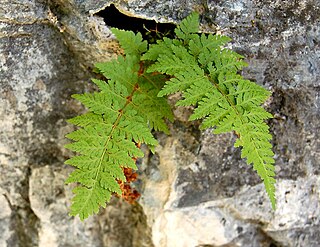
Cystopteris utahensis, commonly called the Utah bladderfern is a rare species of fern found in canyons and on sheltered cliff faces with calcareous rocks. It mainly grows on the Colorado plateau in the western United States, but is also found in a few locations in southern New Mexico and an adjacent area of Texas. Studies of its genetics show that it originates from a natural hybrid of the species Cystopteris bulbifera and Cystopteris reevesiana.
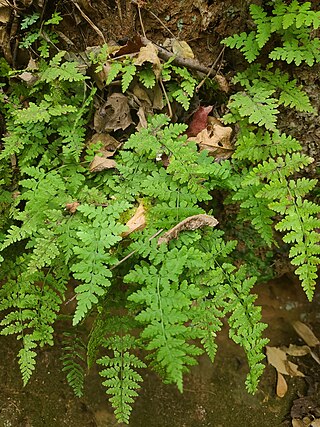
Cystopteris tennesseensis, commonly known as the Tennessee fragile fern or Tennessee bladderfern, is a species of fern in the family Cystopteridaceae.
















